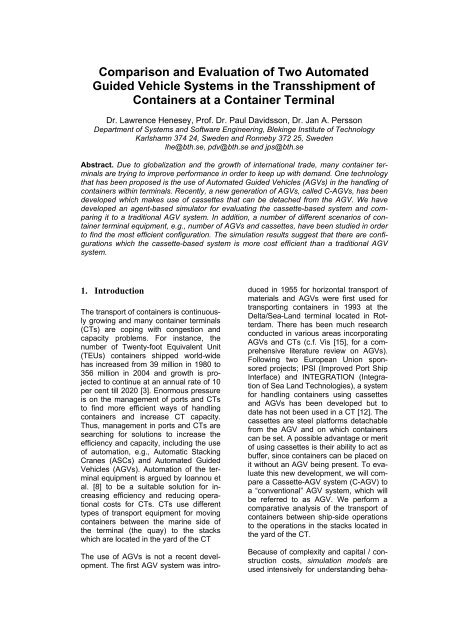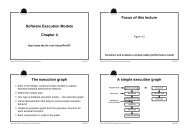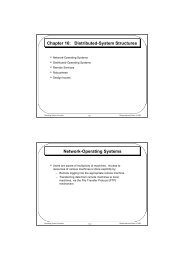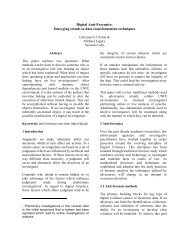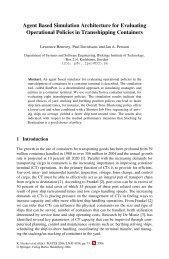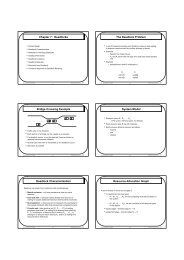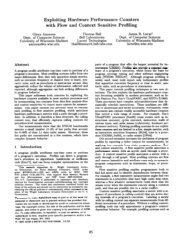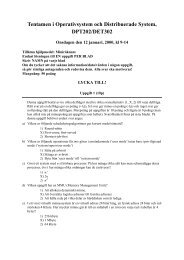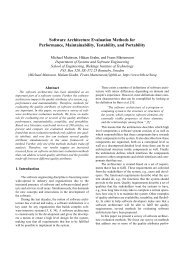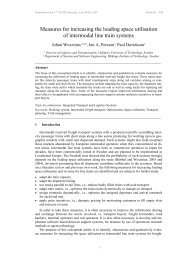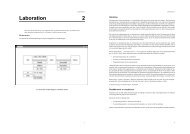Comparison and Evaluation of Two Automated Guided Vehicle ...
Comparison and Evaluation of Two Automated Guided Vehicle ...
Comparison and Evaluation of Two Automated Guided Vehicle ...
You also want an ePaper? Increase the reach of your titles
YUMPU automatically turns print PDFs into web optimized ePapers that Google loves.
<strong>Comparison</strong> <strong>and</strong> <strong>Evaluation</strong> <strong>of</strong> <strong>Two</strong> <strong>Automated</strong><strong>Guided</strong> <strong>Vehicle</strong> Systems in the Transshipment <strong>of</strong>Containers at a Container TerminalDr. Lawrence Henesey, Pr<strong>of</strong>. Dr. Paul Davidsson, Dr. Jan A. PerssonDepartment <strong>of</strong> Systems <strong>and</strong> S<strong>of</strong>tware Engineering, Blekinge Institute <strong>of</strong> TechnologyKarlshamn 374 24, Sweden <strong>and</strong> Ronneby 372 25, Swedenlhe@bth.se, pdv@bth.se <strong>and</strong> jps@bth.seAbstract. Due to globalization <strong>and</strong> the growth <strong>of</strong> international trade, many container terminalsare trying to improve performance in order to keep up with dem<strong>and</strong>. One technologythat has been proposed is the use <strong>of</strong> <strong>Automated</strong> <strong>Guided</strong> <strong>Vehicle</strong>s (AGVs) in the h<strong>and</strong>ling <strong>of</strong>containers within terminals. Recently, a new generation <strong>of</strong> AGVs, called C-AGVs, has beendeveloped which makes use <strong>of</strong> cassettes that can be detached from the AGV. We havedeveloped an agent-based simulator for evaluating the cassette-based system <strong>and</strong> comparingit to a traditional AGV system. In addition, a number <strong>of</strong> different scenarios <strong>of</strong> containerterminal equipment, e.g., number <strong>of</strong> AGVs <strong>and</strong> cassettes, have been studied in orderto find the most efficient configuration. The simulation results suggest that there are configurationswhich the cassette-based system is more cost efficient than a traditional AGVsystem.1. IntroductionThe transport <strong>of</strong> containers is continuouslygrowing <strong>and</strong> many container terminals(CTs) are coping with congestion <strong>and</strong>capacity problems. For instance, thenumber <strong>of</strong> Twenty-foot Equivalent Unit(TEUs) containers shipped world-widehas increased from 39 million in 1980 to356 million in 2004 <strong>and</strong> growth is projectedto continue at an annual rate <strong>of</strong> 10per cent till 2020 [3]. Enormous pressureis on the management <strong>of</strong> ports <strong>and</strong> CTsto find more efficient ways <strong>of</strong> h<strong>and</strong>lingcontainers <strong>and</strong> increase CT capacity.Thus, management in ports <strong>and</strong> CTs aresearching for solutions to increase theefficiency <strong>and</strong> capacity, including the use<strong>of</strong> automation, e.g., Automatic StackingCranes (ASCs) <strong>and</strong> <strong>Automated</strong> <strong>Guided</strong><strong>Vehicle</strong>s (AGVs). Automation <strong>of</strong> the terminalequipment is argued by Ioannou etal. [8] to be a suitable solution for increasingefficiency <strong>and</strong> reducing operationalcosts for CTs. CTs use differenttypes <strong>of</strong> transport equipment for movingcontainers between the marine side <strong>of</strong>the terminal (the quay) to the stackswhich are located in the yard <strong>of</strong> the CTThe use <strong>of</strong> AGVs is not a recent development.The first AGV system was introducedin 1955 for horizontal transport <strong>of</strong>materials <strong>and</strong> AGVs were first used fortransporting containers in 1993 at theDelta/Sea-L<strong>and</strong> terminal located in Rotterdam.There has been much researchconducted in various areas incorporatingAGVs <strong>and</strong> CTs (c.f. Vis [15], for a comprehensiveliterature review on AGVs).Following two European Union sponsoredprojects; IPSI (Improved Port ShipInterface) <strong>and</strong> INTEGRATION (Integration<strong>of</strong> Sea L<strong>and</strong> Technologies), a systemfor h<strong>and</strong>ling containers using cassettes<strong>and</strong> AGVs has been developed but todate has not been used in a CT [12]. Thecassettes are steel platforms detachablefrom the AGV <strong>and</strong> on which containerscan be set. A possible advantage or merit<strong>of</strong> using cassettes is their ability to act asbuffer, since containers can be placed onit without an AGV being present. To evaluatethis new development, we will comparea Cassette-AGV system (C-AGV) toa “conventional” AGV system, which willbe referred to as AGV. We perform acomparative analysis <strong>of</strong> the transport <strong>of</strong>containers between ship-side operationsto the operations in the stacks located inthe yard <strong>of</strong> the CT.Because <strong>of</strong> complexity <strong>and</strong> capital / constructioncosts, simulation models areused intensively for underst<strong>and</strong>ing beha-
vior <strong>and</strong> testing strategies in CTs, e.g.,see [1], [6] <strong>and</strong> [7]. Also, the simulationapproach provides a method <strong>of</strong> evaluatinga concept that has not been used inthe real world [10]. We have developed amulti-agent based simulator (MABS) forcomparing the performance <strong>of</strong> the twoAGV systems according to a number <strong>of</strong>criteria, e.g., service time for a ship, utilizationrate for the CT equipment, <strong>and</strong>operating cost.The remainder <strong>of</strong> the paper is organizedas follows; in Section 1 a description <strong>of</strong>the problem is provided. In Section 2, themethodology <strong>and</strong> model is presented.Section 3 provides a description <strong>of</strong> thesimulation experiments. Results are presented<strong>and</strong> discussed in Section 4. Conclusionsare presented in Section 5 withpointers for future work.2. Problem Description <strong>and</strong> ModelAssumptionsA CT is a place where ships will beberthed so that they can be unloaded<strong>and</strong>/or loaded with containers by QuayCranes (QCs). The CT are <strong>of</strong>ten viewedas an intermodal interface for transport <strong>of</strong>containers between modes <strong>of</strong> transportlinking the l<strong>and</strong>side with the marine-side,e.g., containers are arriving or departingby, ships, trains or trucks <strong>and</strong> while in theCT they are temporarily stored in stacks[7]. In addition, we view CTs as an interfacewithin modes <strong>of</strong> transport, e.g. thetransshipping <strong>of</strong> containers from one shipto another ship in which the containermay be temporarily stored at the CT.Ship owners <strong>of</strong>ten dem<strong>and</strong> a fast turnaroundtime for their ships. By minimizingthe time a ship is berthed at a CT, theship may have more time for sailing <strong>and</strong>thus opportunity for extra voyages, whichimplies that more revenue is generatedby the ship. With the advent <strong>of</strong> “Just-In-Time” philosophy <strong>and</strong> the importance <strong>of</strong>speed in global supply chains, customersdem<strong>and</strong> that their containerized cargo istransported fast <strong>and</strong> on time. Therefore,from a logistics perspective, improvingthe transport within the CT may help indecreasing the total transport time <strong>and</strong>cost <strong>of</strong> transporting cargo in containers.CT managers <strong>of</strong>ten seek to optimize theuse <strong>of</strong> their terminal resources. The mostexpensive piece <strong>of</strong> terminal equipment is<strong>of</strong>ten the quay crane (QC), for which thecapital costs can be € 7 million or more[11]. Other CT resources are the transporters<strong>and</strong> in the case <strong>of</strong> C-AGVs, thecassettes. Many CT managers view theinterface between the QCs <strong>and</strong> the yardas the most critical planning problem [4].An objective that many CT managersshare is to keep the assigned QCs frombeing idle so as to quickly serve (minimizethe turn-around time) a ship.In the problem studied, a ship arrives at aCT with a number <strong>of</strong> containers to beunloaded <strong>and</strong> another set <strong>of</strong> containersare loaded onto the ship before it departs.The unloaded containers are to betransported from the QC area to stacks inthe yard <strong>and</strong> the containers to be loadedare picked-up from stacks <strong>and</strong> transportedto the QC area. This transportationis carried out by AGVs (either “conventional”AGVs or C-AGVs with theiraccompanying cassettes) <strong>and</strong> we call thetime it takes to perform a transport move(including the return without container(s)as well as the load <strong>and</strong> unloading operations)the AGV cycle time. This concept<strong>of</strong> cycle time is similar to that used in astudy comparing a Straddle Carrier systemwith an <strong>Automated</strong> Stacking Cranesystem by Vis [16]. The stacks are locatedin different areas <strong>of</strong> the yard <strong>and</strong>therefore have varying distances to theQC, implying different transport times.We model this by letting the AGV cycletime have r<strong>and</strong>om component for eachtransport. We also consider the time forthe unloading <strong>and</strong> loading <strong>of</strong> containersfrom <strong>and</strong> to a ship by a QC, called thecontainer h<strong>and</strong>ling time.The technical specifications <strong>of</strong> the twoAGV systems is provided courtesy <strong>of</strong>TTS AB <strong>and</strong> presented in Table 1.Table 1: Specifications <strong>of</strong> AGV systemsC-AGV AGVSpeed in km /h 20 15Max. TransportCapacity in TEUs4 2Lifting time 15 sec. n.a.Capital cost inMillions <strong>of</strong> Skr.3,5 2,7Capital cost percassette in Skr.80,000 n.a.
3. Methodology <strong>and</strong> Simulation ModelAs Isoda [9], points out, mapping realworld entities into programming languageshas been one <strong>of</strong> the greatest desires<strong>of</strong> s<strong>of</strong>tware developers. When buildingsimulation models the ability to performsuch mapping is <strong>of</strong> particular importance.Object-oriented modeling supports themapping the behavior <strong>of</strong> objects <strong>and</strong>agent-oriented modeling extends this bysupporting also the modeling <strong>of</strong> proactiveentities as well as the interactionbetween such entities.3.1 Simulation ModelThe entities <strong>of</strong> the real world that wemodel are; QCs, Ships, Buffer, AGVs (C-AGV <strong>and</strong> AGV), cassettes <strong>and</strong> containers.These entities have to coordinatewith each other to complete the maintask, which is the unloading/loading aship. Therefore we model the real worldentities as agents <strong>and</strong> in the simulations<strong>of</strong>tware we implemented them as objectswith their own execution thread.During the simulation these objects worklike processes in the operating system<strong>and</strong> perform their task in parallel. Thisbehavior is close to replication <strong>of</strong> the realworld scenario where the entities <strong>of</strong> thesystem continuously perform their task<strong>and</strong> they sometimes have to coordinatewith each other to finish the main task.The simulation model was implementedusing DESMO-J, an open source libraryfor the JAVA computer programming languagethat is available for download fromthe University <strong>of</strong> Hamburg, Germany,U.H. [13]. DESMO-J provides a runtimeprocess based simulation engine thatcan be used to map port entities to s<strong>of</strong>twareentities <strong>and</strong> to simulate the coordination<strong>of</strong> these process. In the computersimulation, the entities use the ContractNet protocol to coordinate tasks. Thisprotocol is used because <strong>of</strong> its ability todistribute tasks <strong>and</strong> self-organize a group<strong>of</strong> agents [2]. The protocol is suitablesince our model describes tasks that canbe characterized as hierarchical in nature<strong>and</strong> are well-defined. The Contract Netprotocol implies that one agent will takethe role <strong>of</strong> a “manager”, which initiates ajob to be performed by one or more otheragents. The job may require that a number<strong>of</strong> participating agents respond with aproposal <strong>and</strong> the manager will accept aproposal <strong>and</strong> confirm it to a selectedagent <strong>and</strong> reject the other proposals.This protocol seems to closely reflect theoperational decisions that are made bythe actual workers in the CT, especiallywhen a foreman will communicate viaradio with drivers <strong>and</strong> QC operators.The system that we have modeled for anautomated CT using C-AGVs is a singleship that is docked along a quay withcontainer stacks but with two differenttypes <strong>of</strong> AGV systems. We have followeda general simulation process as describedby Law <strong>and</strong> Kelton [10] <strong>and</strong>therefore we are testing a prototype withreal data. We have focused on modelingthe operations that involves the QCs <strong>and</strong>the AGVs that transfer containers betweenthe quay <strong>and</strong> stacks.3.2 Entities in the ModelThe entities that are modeled are thefollowing:• Ship: contains the containers.• Quay cranes: used to unload<strong>and</strong> load the containers.• AGVs (C-AGVs or AGVs): usedto transport container, from/toQC from/to a container stack.• Buffer: Pick-up <strong>and</strong> drop-<strong>of</strong>farea behind the QC that temporarilystores containers on cassettesor AGVs.• Cassettes: A set <strong>of</strong> cassettesbound to a QC.• ContainersThe CT equipment in the simulation arepartly modeled as agents, e.g., QCs, Buffer<strong>and</strong> the AGVs (C-AGVs, <strong>and</strong> AGVs).Ships <strong>and</strong> cassettes are modeled as objectsin the simulator. The agents, whichare considered to be reactive, make theirdecisions, based the state <strong>of</strong> the entity itcorresponds to <strong>and</strong> on the information inthe messages they receive from otheragents. The agents' goals are only implicitlyrepresented by the rules describingtheir behavior. The major advantage inusing reactive agents, according toWooldridge [17]; “is that overall behavioremerges from the interactions <strong>of</strong> thecomponent behaviors when the agent is3
placed in its environment”. In the nextsection we define the agents in the systemin more detail.3.3 Agents in the modelThis section defines the agents <strong>of</strong> thesystem along with their attributes, functions<strong>and</strong> messages.3.3.1 Quay Crane (QC) AgentThe QC is responsible for the unloading<strong>and</strong> loading the containers from <strong>and</strong> tothe ship. The number <strong>of</strong> QCs serving aship is specified by the user.AttributesEach QC has:• a unique name• a set <strong>of</strong> AGVs (C-AGVs orAGVs) assigned to it• a set <strong>of</strong> cassettes (for the C-AGVs)• a buffer area where its cassettesor AGVs can be placed for loading/unloadingcontainers• a container h<strong>and</strong>ling time for unloadinga container, this may bedifferent for each container.Moreover, the following are recorded foreach QC:• the number <strong>of</strong> containers unloadedfrom the ship <strong>and</strong> loadedto the ship• the time it has been working (notincluding the idle time).Functions• In a real CT the QC will have varyingcontainer h<strong>and</strong>ling times,which we simulate by a computergenerated r<strong>and</strong>om number froma uniform distribution in a rangespecified by the user.• When unloading, the QC will unloada container from the ship ifthere is a cassette (or AGV) withfree space in the buffer area. Ifnot, it waits until there is oneavailable.• When there are containers to beloaded available in the bufferarea, the QC will load one containerat a time to the ship.• The QC finishes working whenthere are no containers to be unloadedor loaded for the ship.3.3.2 Buffer AgentA buffer agent is assigned to a QCAttributes• Unique name.• Assigned to a QC.FunctionsA buffer is assigned to a specific QC <strong>and</strong>the buffer is responsible for allocatingfree AGVs to either pick-up a container<strong>and</strong> move it or move empty (to pick-upcontainer(s) at another location). Thebuffer is also responsible for the QC tostop unloading if there is no cassetteavailable or the cassette is full <strong>and</strong> tostop loading if there is no containersavailable on cassettes or on AGVs. TheBuffer agent will communicate with theAGVs <strong>and</strong> assign an AGV that is free topick up a cassette (for the C-AGV). Whenusing AGVs, the buffer agent tries to finda free AGV <strong>and</strong> assign a container to thatAGV. If no AGV is free then it waits untilan AGV is free at the buffer. Pseudocodedescribing the unloading <strong>and</strong> dispatchingstrategy <strong>of</strong> the buffer agent forthe cassette-based system is given below:WHILE still containers to unload DOIF cassette available has capacityfor more containers THENAsk QC to unload a container <strong>and</strong>place it on cassetteAsk all AGVs for their statusWait for status reportsIF AGV idle THENAsk AGV to fetch loaded casetteELSEIF cassette is full THENAsk QC to stop unloadingREPEATAsk all AGVs for their statusWait for status reportsUNTIL at least one AGV is IdleAsk the idle AGV to fetch theloaded cassetteENDWHILE
3.3.3 AGV Agent (C-AGV <strong>and</strong> AGV)Each QC has a number <strong>of</strong> AGVs assignedto it. This value is specified by theuser before the start <strong>of</strong> the experiment.An AGV is responsible to transport containersbetween a QC Buffer <strong>and</strong> containerstacks.AttributesEach AGV has:• a unique name• a state (“free” or “busy”)• a cycle time for transportinga cassette/containerfrom thebuffer to the stack <strong>and</strong>return back to the buffer.Or vice versa during theloading phase. The cycletime can be different foreach move.Moreover, the following are recorded foreach AGV:• the number <strong>of</strong> containerstransported to/from thestack• the time it has beenworking (not includingthe idle time).Functions• An AGV is responsible for transportinga container/cassette thatis assigned to it by the QC.• In a real CT the AGV will havevarying transport times, which wesimulate by a computer generatedr<strong>and</strong>om number using a uniformmethod chosen in a rangespecified by the user.4. Experiment DescriptionThe input parameters are stored in a textfile from which the simulator reads theparameters. The output <strong>of</strong> the simulationis a set <strong>of</strong> files implemented from theDESMO-J library, which contains information<strong>of</strong> all events taken place duringthe simulation. A trace file contains theoverall performance <strong>of</strong> each QC, AGV<strong>and</strong> cassette involved in the simulation.The performance criteria that are usedfor evaluating <strong>and</strong> comparing the CTtransport systems are:• Service Time: is the time it takesto complete the unload/load operationsfor a ship, also known inthe maritime industry as “turnaroundtime”.• Utilization Rate: Active time /Service Time (Active time + Idletime). Active time is the time apiece <strong>of</strong> CT equipment is busy,such as moving a container fromthe QC to a stack <strong>and</strong> Idle time isthe time that it is not working.The utilization rate for the followingCT equipment is recorded:QC, AGV <strong>and</strong> Cassette.• Throughput: Avg. number <strong>of</strong> containersh<strong>and</strong>led per hour duringService time for: QC, AGV <strong>and</strong>Cassette• Total Cost: Equipment cost forserving a ship is calculated in thefollowing ways (OPEX = operatingcost per hour for a unit <strong>of</strong> CTequipment):– QC cost: number <strong>of</strong> QCsx OPEX for QC x ServiceTime.– AGV cost: number <strong>of</strong>AGVs x OPEX for AGV xService Time.– Cassette cost: number <strong>of</strong>cassettes x OPEX forCassette x Service Time.– Total Cost: QC costs+AGV costs + Cassettecosts4.1 Scenario SettingsThe scenario settings were based upondata provided by industrial partners. Theresults from the simulations are based onaverage values, which necessitates thata number <strong>of</strong> simulation trials are made inorder to get a valid estimation. The cycletimes used in the simulation have beendetermined from prior analysis in whichthe stack distances <strong>and</strong> maximumspeeds <strong>of</strong> the AGVs were tested. Weused an approximation method to calculatethe minimum number <strong>of</strong> simulationruns required in order to obtain resultsfrom a simulator with small enough statisticalerrors. The approximation method ispresented in Law <strong>and</strong> Kelton [10] <strong>and</strong>applied by Vis et al. [14] in vehicle allocationat a container terminal. In this me-5
thod, data from a limited number <strong>of</strong> replications(trial sample) is used to approximatethe required minimum number <strong>of</strong>replications in the actual experiment (denotedas i) such that the relative error issmaller than γ (0 < γ
• C-AGV: 60 Skr/hr• Cassette: 0,50 Skr/hrTable 3: Total terminal equipment operatingcosts in Swedish kroner (Skr)Total QC operating costs in (Skr)No. <strong>of</strong> CassettesNo.AGV0 + 1 + 2 + 3 + 41 27 241 27 376 26 743 25 657 25 0692 19 412 19 096 13 937 13 304 12 9873 12 625 12 444 11 720 11 494 11 4944 11 765 11 675 11 584 11 267 11 1325 11 403 11 403 11 358 11 222 11 132Total AGV operating costs1 1 294 1 815 1 773 1 701 1 6622 1 845 2 532 1 848 1 764 1 7223 1 800 2 475 2 331 2 286 2 2864 2 236 3 096 3 072 2 988 2 9525 2 709 3 780 3 765 3 720 3 690Total cassette operating costs1 n.a. 15 30 43 552 n.a. 21 31 44 573 n.a. 21 39 57 764 n.a. 26 51 75 985 n.a. 32 63 93 123The operating costs for both AGV systemsincrease as more AGVs are used,however, C-AGVs operating costs decreaseas more cassettes are deployedto work with each C-AGV. There exist atrade-<strong>of</strong>f in that additional cassettes increasethe operating costs associated forcassettes, hence we need to considerthe total costs.Table 4. Total operating costs for servinga ship in Swedish kroner (Skr).No.AGVNo. <strong>of</strong> Cassettes0 + 1 + 2 + 3 + 41 28 535 29 206 28 545 27 400 26 7862 21 257 21 649 15 816 15 112 14 7663 14 424 14 939 14 090 13 837 13 8564 14 001 14 796 14 707 14 330 14 1825 14 112 15 215 15 186 15 035 14 945In comparing the total operating costs inTable 4, the addition <strong>of</strong> AGVs <strong>and</strong> cassettesleads to lower costs until three C-AGVs <strong>and</strong> three cassettes are employed.The total costs when adding furtherequipment increases, i.e., the timegained does not compensate for the extracosts. A possible choice for assigningCT equipment in the scenario studiedwould be the use <strong>of</strong> three C-AGVs withthree cassettes each.6 Discussion <strong>and</strong> Future WorkThe cassette-based system (C-AGV)posses some advantages in that it canact as a ‘floating’ buffer, meaning that itcan allow the QCs to keep unloading/loading<strong>and</strong> not having to wait for anAGV to be available. Waiting time is lowerfor the QCs <strong>and</strong> thus they are obtainingbetter utilization rates. The initial resultsfrom the prototype AGV simulatorprovide some interesting observationsuseful for determining the number <strong>of</strong>units to allocate for serving a ship. Thesimulation experiments conducted arealso creating further questions that requiremore investigation. Naturally thereis a trade-<strong>of</strong>f to be expected betweenservice time <strong>and</strong> the costs for purchasing<strong>and</strong> operating equipment.Compared to traditional simulation approaches,the agent-based modeling approachcan provide better granularity inmodeling the entities <strong>and</strong> having themcommunicate <strong>and</strong> coordinate amongstother entities. In Elder [5], he mentionsthe advantages <strong>of</strong> simulation methodsover queuing techniques <strong>and</strong> we als<strong>of</strong>ind it difficult with traditional queuingmodels to model problems such as theAGV dispatching strategies (in this studycarried out by the Buffer agent) that areused when applying cassette-based systems.The simulator has provided usmuch insight in the relationships amongvarious terminal equipment types thatcan be used in container terminal operations.For future work we would study othermodels for container h<strong>and</strong>ling time by theQC <strong>and</strong> the cycle time for AGVs (e.g.,including stoppages caused by malfunctioningequipment, etc. which affects theproductivity at a real CT). Another topicworth studying is different dispatchingstrategies for allocating containers toAGVs <strong>and</strong> cassettes. We plan to extendthe model in several directions, e.g., includingthe unloading/loading taking7
place at the stacks, more detailed modeling<strong>of</strong> the AGV movements, etc.REFERENCES1. Bruzzone, A.G., Giribone, P. & Revetria,R. (1999) "Operative requirements<strong>and</strong> advances for the newgeneration simulators in multimodalcontainer terminals," 1999 WinterSimulation Conference. Society forComputer Simulation International.2. Clearwater, S.H. (1996) Market-Based Control: A Paradigm for DistributedResource Allocation, WorldScientific: Singapore.3. Davidson, N. (2005) A global capacityassessment <strong>and</strong> needs analysis.39th Terminal Operating Conference.Antwerp, Belgium: Informa Plc.4. De Monie, G. (2005) EnvironmentalScanning in Ports, ITMMA PrivatePublic Partnerships in Ports: Antwerp,Belgium5. Elder, M. (2005) "Simulation beatsQueuing," SIMUL8.6. Hayuth, Y., Pollatschek, M.A. & Roll,Y. (1994) "Building a Port Simulator".Simulation, vol. 63, no 3 pp. 179-189.7. Henesey, L., Davidsson, P. & Persson,J. A. (2006) "Agent Based SimulationArchitecture for Evaluating OperationalPolicies in TransshippingContainers". Fourth German Conferenceon Multiagent System Technologies(MATES 2006). LNAI 4196,K. Fischer et al. (Eds), Springer-Verlag Berlin Heidelberg, Germany,pp. 73-85.8. Ioannou, P.A., Kosmatopoulos, E.B.,Jula, H., Collinge, A., Liu, C.-I. &Asef-Vaziri, A. (2002) Cargo H<strong>and</strong>lingTechnologies. Technical Report.Department <strong>of</strong> Electrical Engineering,University <strong>of</strong> Southern California:Los Angeles, pp. 1-147.9. Isoda, S. (2001) Object-oriented realworldmodeling revisited. Journal <strong>of</strong>Systems <strong>and</strong> S<strong>of</strong>tware, vol. 59, no. 2,pp. 153-162.10. Law, A.M. & Kelton, W.D. (2000) SimulationModeling <strong>and</strong> Analysis. 3ed., McGraw-Hill International: Boston11. Rida, M., Boulmakoul, A., & Laurini,R. (2003) "Calibration <strong>and</strong> validation<strong>of</strong> container terminal simulation".Signal Processing <strong>and</strong> InformationTechnology, ISSPIT 2003. Proceedings<strong>of</strong> the 3rd IEEE InternationalSymposium, pp. 774-777.12. TTS AB Port Equipment;http://www.ttsmarine.com/default.aspx.(site lastchecked 24, 05, 2007).13. University <strong>of</strong> Hamburg Department <strong>of</strong>Computer Science, DESMO-J.14. Vis, I.F.A., de Koster, R. & Savelsbergh,M.W.P. (2005) "Minimum vehiclefleet size under time-windowconstraints at a container terminal,"Transportation Science, vol. 39, no.2, pp. 249-260.15. Vis, I.F.A. (2006) "Survey <strong>of</strong> researchin the design <strong>and</strong> control <strong>of</strong> automatedguided vehicle systems". EuropeanJournal <strong>of</strong> Operational Research,vol. 170, no. 3, pp. 677-709.16. Vis, I.F.A. (2006) "A comparativeanalysis <strong>of</strong> storage <strong>and</strong> retrievalequipment at a container terminal,"International Journal <strong>of</strong> ProductionEconomics, vol.103, no. 2 pp. 680-693.17. Wooldridge, M. (2002) An Introductionto Multi Agent Systems, WestSussex, John Wiley <strong>and</strong> Sons Ltd.:Suffolk, Engl<strong>and</strong>.


